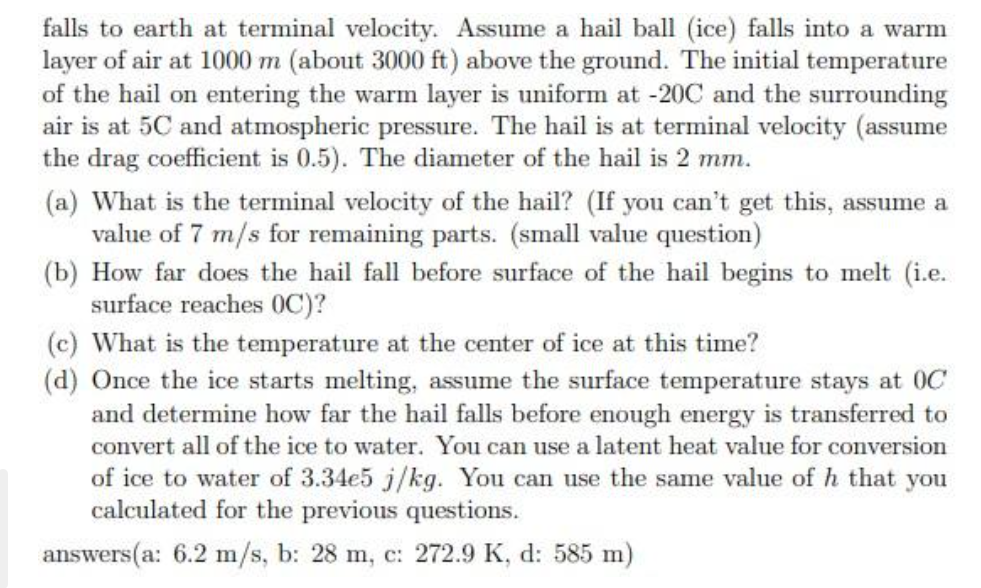falls to earth at terminal velocity. Assume a hail ball (ice) falls into a warm layer of air at 1000 m (about 3000 ft) above the ground. The initial temperature of the hail on entering the warm layer is uniform at -20C and the surrounding air is at 5C and atmospheric pressure. The hail is at terminal velocity (assume the drag coefficient is 0.5). The diameter of the hail is 2 mm. (a) What is the terminal velocity of the hail? (If you can't get this, assume a value of 7 m/s for remaining parts. (small value question) (b) How far does the hail fall before surface of the hail begins to melt (i.e. surface reaches 0C)? (c) What is the temperature at the center of ice at this time? (d) Once the ice starts melting, assume the surface temperature stays at OC and determine how far the hail falls before enough energy is transferred to convert all of the ice to water. You can use a latent heat value for conversion of ice to water of 3.34e5 j/kg. You can use the same value of h that you calculated for the previous questions. answers(a: 6.2 m/s, b: 28 m, c: 272.9 K, d: 585 m)
falls to earth at terminal velocity. Assume a hail ball (ice) falls into a warm layer of air at 1000 m (about 3000 ft) above the ground. The initial temperature of the hail on entering the warm layer is uniform at -20C and the surrounding air is at 5C and atmospheric pressure. The hail is at terminal velocity (assume the drag coefficient is 0.5). The diameter of the hail is 2 mm. (a) What is the terminal velocity of the hail? (If you can't get this, assume a value of 7 m/s for remaining parts. (small value question) (b) How far does the hail fall before surface of the hail begins to melt (i.e. surface reaches 0C)? (c) What is the temperature at the center of ice at this time? (d) Once the ice starts melting, assume the surface temperature stays at OC and determine how far the hail falls before enough energy is transferred to convert all of the ice to water. You can use a latent heat value for conversion of ice to water of 3.34e5 j/kg. You can use the same value of h that you calculated for the previous questions. answers(a: 6.2 m/s, b: 28 m, c: 272.9 K, d: 585 m)
Principles of Heat Transfer (Activate Learning with these NEW titles from Engineering!)
8th Edition
ISBN:9781305387102
Author:Kreith, Frank; Manglik, Raj M.
Publisher:Kreith, Frank; Manglik, Raj M.
Chapter5: Analysis Of Convection Heat Transfer
Section: Chapter Questions
Problem 5.57P
Related questions
Question

Transcribed Image Text:falls to earth at terminal velocity. Assume a hail ball (ice) falls into a warm
layer of air at 1000 m (about 3000 ft) above the ground. The initial temperature
of the hail on entering the warm layer is uniform at -20C and the surrounding
air is at 5C and atmospheric pressure. The hail is at terminal velocity (assume
the drag coefficient is 0.5). The diameter of the hail is 2 mm.
(a) What is the terminal velocity of the hail? (If you can't get this, assume a
value of 7 m/s for remaining parts. (small value question)
(b) How far does the hail fall before surface of the hail begins to melt (i.e.
surface reaches OC)?
(c) What is the temperature at the center of ice at this time?
(d) Once the ice starts melting, assume the surface temperature stays at OC
and determine how far the hail falls before enough energy is transferred to
convert all of the ice to water. You can use a latent heat value for conversion
of ice to water of 3.34e5 j/kg. You can use the same value of h that you
calculated for the previous questions.
answers(a: 6.2 m/s, b: 28 m, c: 272.9 K, d: 585 m)
Expert Solution
This question has been solved!
Explore an expertly crafted, step-by-step solution for a thorough understanding of key concepts.
Step by step
Solved in 6 steps

Knowledge Booster
Learn more about
Need a deep-dive on the concept behind this application? Look no further. Learn more about this topic, mechanical-engineering and related others by exploring similar questions and additional content below.Recommended textbooks for you

Principles of Heat Transfer (Activate Learning wi…
Mechanical Engineering
ISBN:
9781305387102
Author:
Kreith, Frank; Manglik, Raj M.
Publisher:
Cengage Learning

Principles of Heat Transfer (Activate Learning wi…
Mechanical Engineering
ISBN:
9781305387102
Author:
Kreith, Frank; Manglik, Raj M.
Publisher:
Cengage Learning